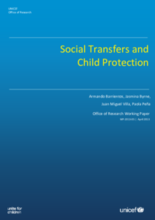The term ‘social transfers’ is defined by the authors as regular, reliable and direct transfers in cash and/or in kind to households in poverty and deprivation. Social transfers are typically implemented to reduce poverty and promote economic inclusion. This study, published by the UNICEF Office of Research and the Brooks World Poverty Institute, examines the direct, indirect, and implementation impacts of social transfers on child protection outcomes in low- and middle-income countries. This paper focuses on the ways in which social transfer programs promote the welfare of children, specifically by improving child protection outcomes such as the prevention and reduction of the damaging effects of: family separation, child labor, trafficking, child marriage, violence, abuse, and exploitation of children. The paper offers suggestions for utilizing, and enhancing, the connections between social transfer programs and child protection strategies to improve outcomes for children.
In analyzing 79 impact evaluation studies covering 45 social transfer programs in 28 countries, the authors have found that social transfers directly affect child protection outcomes, positively or negatively, when child protection is explicitly incorporated into the design and implementation of the program, or when the objectives of the program impact the adult caretakers’ provision of care to children. The paper also finds that social transfers can indirectly affect child protection outcomes by impacting the economic stability of the child’s family. Poverty and economic exclusion often increase a child’s vulnerability to violence, abuse, and exploitation and social transfers that alleviate the effects of poverty may more effectively improve child protection outcomes. Additionally, the authors suggest that the implementation of social transfer programs impacts child protection outcomes when it contributes to the capacity of child protection agencies and other public organizations to protect children from violence, abuse, and exploitation. The authors assert that, though not captured in this paper’s database of impact evaluation studies, other linkages between social transfers and child protection may likely exist.
Several indicators that are relevant to family separation - including children in formal or informal care, child-headed households, and unaccompanied children - were explicitly mentioned in the program evaluations of social transfers reviewed in this report. The paper found that social transfers impact family separation in several ways, especially through their effects on mitigating the impact of migration and conflict on children. Social transfers can prevent family separation by allowing parents to avoid involuntarily migrating from rural to large urban areas as job seekers, encouraging families to return to the places they were forced to leave, and allowing parents to spend more time with their children and strengthen their intra-household relations. However, social transfers can also promote family separation by providing opportunities for parents who are willing to work in larger urban centres, leaving their children in rural areas, or by helping children to accumulate more human capital, increasing the likelihood that they will leave their homes in search of better employment opportunities. Cooperation, integration, and partnership between social transfer programs and child protection agencies can enhance agencies’ ability to effectively promote the protection of children. Therefore, there is an urgent need, the authors argue, for further research on this topic. Furthermore, the authors suggest that a systems approach, that emphasizes creating a protective environment for children, will enhance the connections between social transfers and child protection outcomes.
©Brooks World Poverty Institute, University of Manchester; UNICEF Office of Research Working Paper

